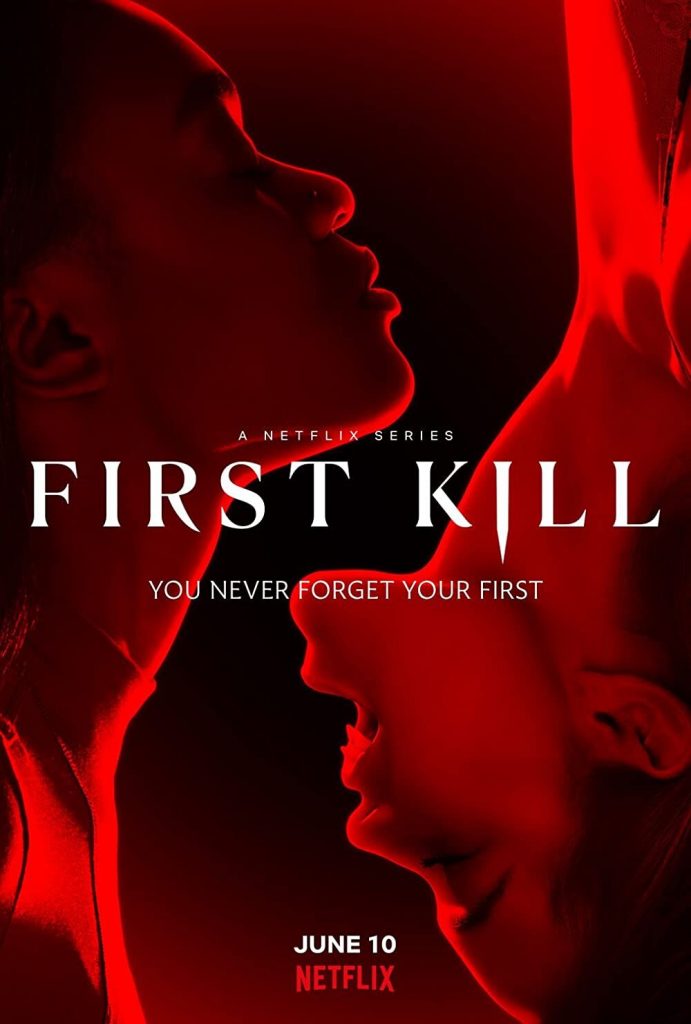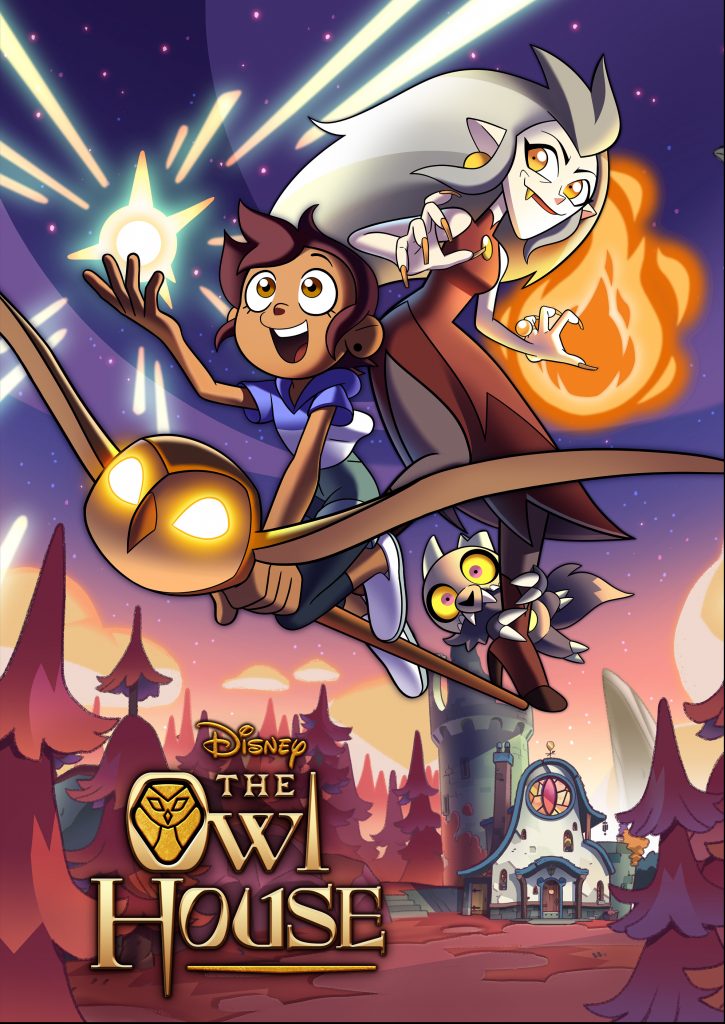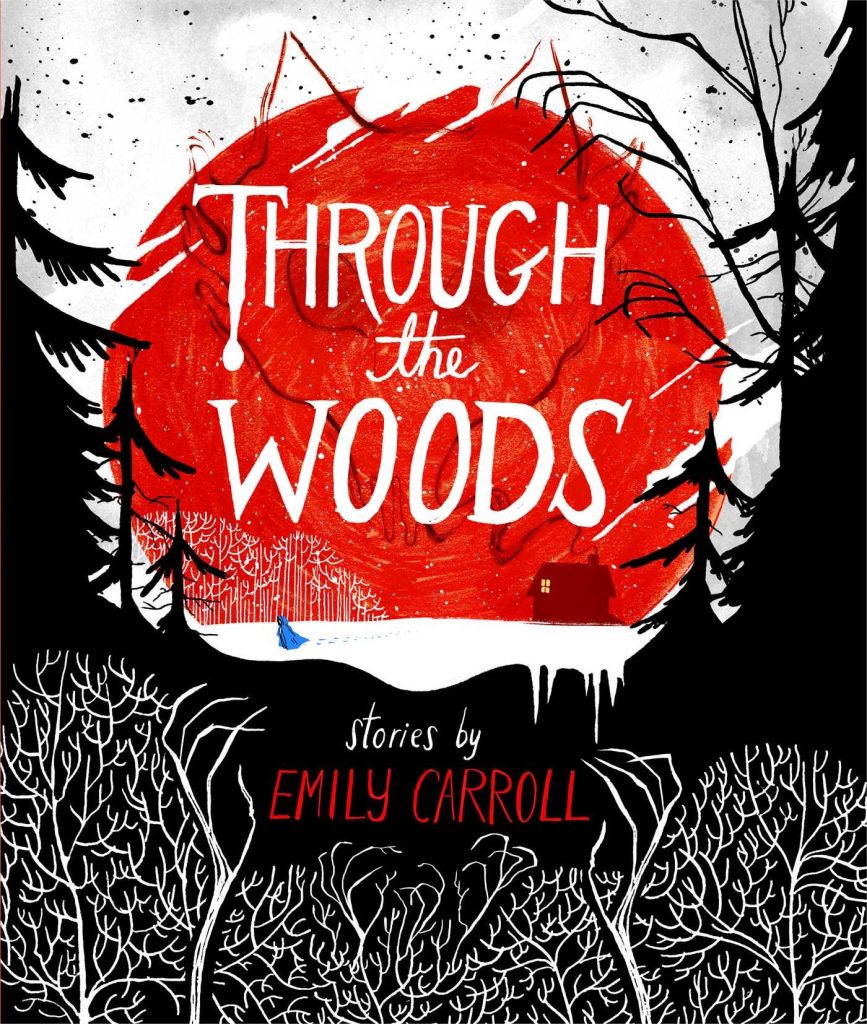First Kill
By Catherine Hall

Halfway between Romeo and Juliet and Twilight stands Netflix’s new vampire drama, First Kill. Based on a short story by V.E. Schwab, the show follows Juliette Fairmont, the youngest descendant of the most ancient family of vampires, who falls in love with Calliope Burns, the new girl in school who just so happens to be part of a family of monster slayers. Sparks fly from their very first meeting, but these two star-crossed lovers also each intend to make the other their first kill. How’s that for forbidden love?
Numerous critics have lambasted the show for being cliché and cheesy, and some of these criticisms are justified: the conflict is melodramatic, the plot twists are predictable, and the monsters are generic and poorly animated. I was incredibly disappointed to see that the most interesting lore elements were vastly underexplored (the concept of legacy vampires, who are born rather than made, definitely deserved more attention). And yes, Juliette and Calliope’s relationship is cheesy like a poorly written fanfiction. But honestly? That’s what I like about it.
First Kill truly owns up to its cheesiness, as it should. Juliette and Calliope don’t have much in common other than teenage angst and a weird obsession with Romeo and Juliet. Nevertheless, their attraction runs deep and pushes them to act against their families’ wishes numerous times. Perhaps that’s not realistic. It’s definitely somewhat ridiculous, but since when have realism and reason been at the heart of romance? Dozens of equally ridiculous romances are released every year, and it’s about time we got a sapphic version of them.
The show also references several famous romances and vampire tales, from name-dropping Bella and Edward in the theme song to the repeated use of Romeo and Juliet quotes. The show tells us that this is a story that we have watched and read countless times before. First Kill might not be award-winning television, but it never tried to be. First Kill is wonderfully absurd, and really, we deserve more lesbian fiction that combines the cheesy and the supernatural.
Across a Field of Starlight
Par Chloë Zaffran
Across a Field of Starlight par Blue Delliquanti est un roman graphique publié en 2022. Les protagonistes, Lu (iel) et Fassen (iel) se rencontrent par accident et deviennent ami.e.s, communiquant pendant des années uniquement par vidéo-messages instantanés, à travers maintes années-lumière. Clair et vif, le style artistique apporte un réel dynamisme aux scènes d’action parsemées à travers le roman. L’histoire suit Fassen et son ascension au sein d’une rébellion, les Fireback, contre l’Ever-Blossoming Empire, une puissance impérialiste et totalitaire.
Les deux jeunes passent autant de temps à s’envoyer des messages intersidéraux qu’à leurs occupations respectives. Leur relation est passionnante à suivre: Fassen raconte à Lu son ascension au sein des Fireback, et en retour Lu lui raconte ses recherches et lui offre son soutien. L’enthousiasme qu’iels partagent donne au roman tout son charme.
Cette relation est d’autant plus touchante dans le contexte d’une pandémie. Les protagonistes sont séparé.e.s non seulement physiquement, mais par des systèmes de gouvernance radicalement différents. Fassen est d’une loyauté sans faute, et déterminé.e à faire de son mieux au sein des Fireback que pour Lu. Cette situation mène à de très intéressants conflits émotionnels que j’ai rarement vus auparavant dans des romans graphiques pour jeunes adultes.
Across a Field of Starlight m’attire autant par ses vives couleurs que par son excellente compréhension de la condition humaine dans des différents environnements. Le roman touche à toutes sortes de sujets tels que l’identité de genre, la méritocratie, et bien d’autres. Tous ces sujets sont explorés avec l’espoir d’apporter de nouvelles solutions sans compromis. Blue Delliquanti a créé une fantastique aventure de science-fiction, style space-opéra avec un univers riche et fascinant à découvrir, une histoire pleine d’amitié, de tendresse aux moments les plus difficiles, de conflits entre deux personnes qui se respectent énormément, et de résolutions difficiles mais satisfaisantes et nécessaires. Across a Field of Starlight est un space-opéra bien écrit et dessiné, parfait à dévorer sur son balcon en une après-midi.
The Owl House
Par Magdalena Nitchi

The Owl House est un dessin animé fantasy avec des éléments d’horreur et de comédie produit par Dana Terrace. La deuxième saison de 40 épisodes a récemment pris fin et une troisième saison, composée de trois spéciaux de 44 minutes, est en cours de production.
Lorsque Luz, une jeune adolescente humaine, trouve un portail vers un royaume démoniaque magique appelé « les îles bouillantes » , c’est un rêve devenu réalité. Elle a voulu devenir sorcière toute sa vie, et maintenant, elle a une chance de faire de la vraie magie. Elle se lie rapidement d’amitié avec une sorcière rebelle, « the Owl Lady » Eda Clawthorne, et son petit colocataire, le démon King. La première saison se concentre sur l’apprentissage de la magie par Luz, qui mène à une aventure légère et amusante à travers ce nouveau monde. La deuxième saison développe une intrigue étroitement tissée, dans laquelle Luz aide Eda avec une malédiction magique et lutte contre l’infâme empereur des îles bouillantes, afin de retourner dans le royaume humain.
The Owl House a reçu plusieurs prix pour sa représentation LGBTQ+, et ils sont bien mérités. Luz est ouvertement bisexuelle et Amity, l’un des autres personnages principaux, est lesbienne. Plusieurs autres personnages font partie de la communauté LGBTQ+, dont Raine Whispers, qui est ouvertement non-binaire, abordant de manière appropriée pour des enfants ces définitions et ces concepts.
Il est rafraîchissant de voir une telle diversité dans une émission pour enfants; c’est un grand pas en avant pour la représentation LGBTQ + dans l’animation. Il faut aussi reconnaître que ce pas en avant vu dans The Owl House doit son héritage à d’autres émissions, telles que The Legend of Korra, Steven Universe, et la nouvelle version de de She-Ra and the Princesses of Power, qui se sont toutes battues pour une plus grande représentation LGBTQ + dans les dessins animés. J’apprécie également le fait que l’homophobie ne semble pas exister sur les îles bouillantes; les personnages ne font jamais face à aucune forme d’hostilité pour être ceux qui ils sont, et leur identité n’est jamais mise en question. Le spectacle est également diversifié à d’autres égards; Luz est dominicaine-américaine et les sorcières des îles bouillantes sont de provenances diverses aussi.
Bien que l’émission ait été clairement conçue pour un public plus jeune, The Owl House est agréable pour tous les âges. Les thèmes tels que la famille retrouvée et la lutte contre les régimes oppressifs peuvent faire pleurer n’importe qui. The Owl House n’est disponible que sur Disney +, mais si vous avez un compte, je le recommande vivement.
Through the Woods
By Magdalena Nitchi
Through the Woods is a beautiful collection of comics by Emily Carroll, who is known for her viral horror comics, including His Face All Red. The collection contains five longer narrative comics, an eerie introduction, and a spine-tingling conclusion. While the comics are not interconnected, they all share a similar premise: a journey into the terrifying abyss of the unknown.
Reading Carroll’s webcomics in a physical book is a wonderful experience. The size of the pages allows the reader to really take in the details of the art and nuances of colour, which can sometimes be lost on a digital screen. I enjoyed both rediscovering some of her work that I had previously read, and experiencing some of it for the first time.
My favourite comic from the collection, “My Friend Janna,” begins with Janna performing fake ghostly séances for her neighbours with the aid of the nameless protagonist. However, the protagonist soon notices something is wrong, and sees that Janna is being haunted by a real supernatural entity. The unsettling feeling of this comic is fantastic; Carroll’s delicate yet sinister style is perfect for horror. Her backgrounds come alive, with trees seemingly grasping at the girls as they wander through the woods and the walls of a bedroom closing in around the protagonist. In “My Friend Janna” Caroll uses colour to add to the horror; as the story progresses all colour drains from the background and the girls’ pink faces turn into an unhealthy-looking red.
Through the Woods’ comics ultimately have a dark, fairytale-like feeling. Carroll’s talent for visual arts is evident, and she truly brings these original stories to life. None of the comics contain any overtly LGBTQ+ characters or themes, but I wanted to include this book to highlight the importance of supporting LGBTQ+ authors, even when their work is not overtly queer. If you are curious to see more of her work, then feel free to check out her website!
D’autres oeuvres LGBTQ+ qu’on vous recommande | Other LGBTQ+ works we recommend:
- They Both Die at the End / Et its meurent tous les deux à la fin – Adam Silvera, Robert Laffont (FR)
- Her Majesty’s Royal Coven – Juno Dawson
- The Priory of the Orange Tree – Samantha Shannon
- Querelle de Roberval – Kevin Lambert
- Everything, Everywhere, All At Once – dir. Daniel Kwan, Daniel Scheinert
- Wild and Wicked Things – Francesca May
- The House in the Cerulean Sea – TJ Klune
- More Than This – Patrick Ness
- Fierce Femmes and Notorious Liars / Fèms Magnifiques et dangereuses – Kai Cheng Thom, Kama La Mackerel (FR)
- Monstrous Regiment – Terry Pratchett
- Love Beyond Body, Space, and Time: An Indigenous LGBT Sci-fi Anthology – ed. Hope Nicholson
- Black Lightning – prod. Robert West


